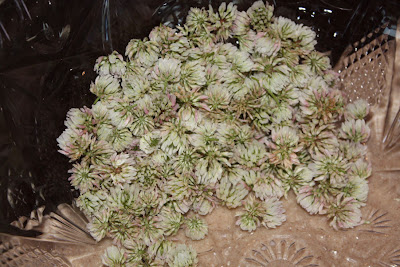CLOVER,
RED AND WHITE – Trifolium repens (USDA), Biennial/Perennial Forb/Herb
Family – Fabaceae (Pea Family)
Genus – Trifolium (Clover)
Sometimes the best things in life are just right under your nose
and for whatever reason you miss them. In
the case of White Clover, even the forager of wild plants might sometimes
overlook such an important, yet easily attainable plant. Quite possibly it’s too
obvious and abundant to be any good or maybe it’s just too easy and attainable to be
worth anything of substance. Although it
is true that this plant is very abundant, easy to find and easily harvested, it
is absolutely not true that it does not have value because it has multiple
edible uses.
White Clover - Trifolium Repens
There are 170 species in the Trifolium genus, of which, at least
23 are located right here in the south.
Many of these can be used in similar ways as white clover. Trifolium in Latin simply means “three” and “leaves”
as the plant is often associated with the shamrock which is an important symbol
in Ireland. St. Patrick used the
shamrock as a metaphor for the Holy Trinity and white clover, Trifolium Repens,
is one of the clovers considered a true shamrock which makes this plant and the
tea made from it extra special to me.
The species is introduced from Eurasia many years ago and was a very
important plant to the Native Americans.
White Clover, Red Clover and Crimson Clover are all easily recognized from each other when in flower, and when not it is a little more difficult. The flowering heads of both white and red clover are similar in size and shape, the color being the main difference but Crimson cover below is easily recognized because the inflorescence is much taller than the red or white clovers. The have smooth, creeping stems, inversely heart-shaped leaflets with long and slender petioles and peduncles. The flower heads are loose and umbel-shaped. The leaves of white clover often creep along the ground in thick patches and the white flowers are on separate stalks and sometimes are tinged with pink, especially near the base. They have a pleasant sweet smell. The leaflets sometimes have pale triangular markings.
White Clover, Red Clover and Crimson Clover are all easily recognized from each other when in flower, and when not it is a little more difficult. The flowering heads of both white and red clover are similar in size and shape, the color being the main difference but Crimson cover below is easily recognized because the inflorescence is much taller than the red or white clovers. The have smooth, creeping stems, inversely heart-shaped leaflets with long and slender petioles and peduncles. The flower heads are loose and umbel-shaped. The leaves of white clover often creep along the ground in thick patches and the white flowers are on separate stalks and sometimes are tinged with pink, especially near the base. They have a pleasant sweet smell. The leaflets sometimes have pale triangular markings.
Crimson Clover - Trifolium incarnatum
~Click to Enlarge~
As a child I can remember spending what seemed like hours
searching for the elusive four leaved clover along the shoulders of roads near
my house and I remember finding a few, but not more than that. Had I been more creative at the time, I’d
have dried and framed them, but I didn’t, so you’ll just have to take my word
for it.
Driving down the back country roads and even major highways
large patches of both white clover (T. Repens) and red clover (T. Pretense) are
easily spotted by their white or red blooms no matter how fast you are
going. Neither of the two are very easily
digested raw, but dried or cooked; the leaves and roots have multiple
nutritional uses.
Although the plant isn’t the greatest when eaten raw, it makes
an excellent soothing and relaxing tea. The
flowers can be dried for later use, or used fresh as I have done. The following recipe created a half pitcher
of tea:
1 ½ cup of the white flower-heads
8 cups of water
Fragrant Flower Heads of Trifolium Repens
~Click to Enlarge~
Put the water over heat and add all of the flower heads. Bring to a boil and cut off the burner and
let seep for 5 minutes. Pour into cup
and sweeten to taste by adding either honey or sugar.
Wash the Flower Heads Under Cold Water
~Click to Enlarge~
Strain While Heating or dump into the Water
~Click to Enlarge~
It’s that simple and very worth your time to try this.
It is said that the Native Americans even cultivated clover for
food. They ate the plant raw, but also steamed
the thin roots or smoked the entire plant over a fire. Soaking the plant in salty brine for several
hours also makes it more palatable.
There are multiple other uses for this plant. The flowers and seeds can be dried and pulverized
into flour for making breads or for soup thickeners. The
flowers can also be made into syrup. The
leaves and flowers can be eaten in small quantities raw, or in great quantities
cooked or soaked in a brine solution.
The roots can be steamed or cooked and eaten.





I had no idea that you had a blof. Nice job!
ReplyDelete